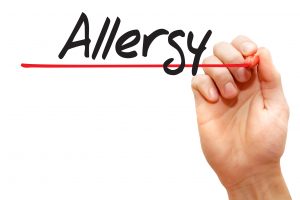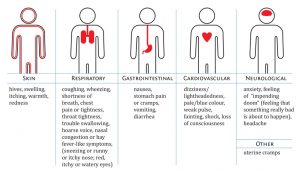
If you have food allergies or if you know someone who does, you need to understand the signs and symptoms of anaphylaxis. Take a moment to review them now and share this information. It could save a life.
Symptoms of Anaphylaxis
- Skin: hives, swelling, itching, warmth, redness, rash
- Breathing (respiratory): coughing, wheezing, shortness of breath, chest pain/tightness, throat tightness/swelling, hoarse voice, nasal congestion or hay fever-like symptoms (runny nose and watery eyes, sneezing), trouble swallowing
- Stomach (gastrointestinal): nausea, pain/cramps, vomiting, diarrhea
- Heart (cardiovascular): pale/blue colour, weak pulse, passing out, dizzy/lightheaded, shock
- Other: anxiety, feeling of “impending doom”, headache, uterine cramps, metallic taste in mouth
NOTE: Symptoms can be different from one reaction to the next, even if it is the same allergen.
When do symptoms start?
An allergic reaction usually happens within minutes after being exposed to an allergen, but sometimes it can take place several hours after exposure. A biphasic (repeat) reaction can also happen within several days of a food allergy reaction.
Kids and anaphylaxis
Children may describe their symptoms in different ways. A child might say “My tongue is fuzzy” or “My throat feels funny”. A young child may simply become very quiet because they don’t understand what is happening. A tween or teen might not want to say what’s happening, due to peer issues or anxiety. If something seems wrong, check for signs, ask questions and take action at the early signs of a reaction.
Use the EpiPen®
Know how to use the EpiPen® — and don’t be afraid to use it. Epinephrine is safe and effective, and it is the only treatment that reverses anaphylaxis. It should be used at the first signs of a reaction. Do NOT watch and wait for a reaction to get worse before administering the EpiPen®. Do not wait for the EMTs to arrive before using the EpiPen®. A delay in using the EpiPen®can lead to death.
Use the EpiPen®, then call 911.
The 5 Emergency Steps
Here are the steps to take if someone is having a food allergy reaction.
- Give epinephrine (e.g. ,EpiPen®) at the first signs of an allergic reaction.
- Call 911 or your local emergency medical services and tell them that someone is having an anaphylactic reaction.
- You can give a second dose of epinephrine as early as 5 minutes after the first dose if there is no improvement in symptoms.
- Go to the nearest hospital right away (ideally by ambulance), even if symptoms are mild or have stopped.
- Call the emergency contact person (e.g., parent, guardian, spouse).
At the Hospital
Once you arrive at the hospital, you may be asked to stay for several hours. The hospital will monitor and provide care, because there is a possibility that the symptoms of anaphylaxis could come back (this is known as a biphasic reaction) or that the person could need some other care.
If you are assisting a friend who has had a reaction, stay with them at the hospital until they are released.
More information:
Like what you’re reading? Support Food Allergy Canada!
Tags: Anaphylaxis, how to tell if you're having a reaction, signs and symptoms
